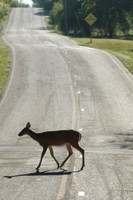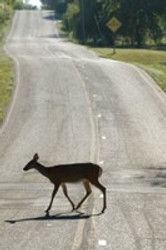10 Tips to Avoid a Deer Collision
Posted by Deerbusters on 5th May 2014

It’s deer season and as a deer fence company, we know that deer can be damaging to your yard and garden – but they can also be damaging to your car. No matter where you’re drive to, stay alert and follow these tips to avoid a deer collision:
Watch for deer crossing signs.
This may seem like common sense, but many people don’t pay enough attention to road signs when they drive. Deer crossing signs are put in areas of high deer traffic, so when you see one, slow down and stay alert.
“If there’s one, there are probably more.”
If you see a deer in or around the road, slow down and at a slower speed for another quarter mile or so. When there’s one deer, there are usually more around – even if you can’t see them.
Don’t speed.
Speeding is not only against the law, but it works against you if you have to stop suddenly for a deer. Hitting a deer at a higher speed can also cause more damage to your car and increase your risk of injury.
Update your brakes.
Having quality brakes can be the difference between hitting a deer and stopping quickly enough to avoid it. If your brake pads are worn, change them out. The same goes for your car’s rotors. You’ll be thankful the next time you see a deer and have to stop short.
Know when to swerve.
Many times, a driver’s instinct is to swerve when he/she sees a deer. However, if swerving means putting yourself in the path of oncoming traffic or into the woods, it’s not such a good idea. If there are cars in the other lane and the only option you have is to swerve or hit the deer, hit the deer. You’ll do far less damage to your car than if you hit someone else.
Honk and blink.
If you see a deer and there are no other cars around, attempt to scare the deer away by honking in bursts. Also, deer seem to go into a trance while looking at headlights, so blink your high beams to startle them.
Pay attention at sunrise and sunset.
Deer migrate the most around sunrise and sunset, when it’s cooler. Since our eyes have trouble fully adjusting to the lighting at these times, it’s important to be wary of your surroundings and on the lookout for moving deer.
Wear your seat belt.
This may seem like another common-sense tip, but many drivers are injured when an accident occurs and they aren’t wearing their seat belts. If you hit a deer, your seat belt may help you avoid getting hurt.
Look for movement.
Deer are often found in brush, tall grasses, and fields – and are usually camouflaged well – so look for movement a few feet above the ground in these areas.
Expect the unexpected.
Even if you see a deer on the side of the road, there’s no certainty that it will stay there. Deer are unpredictable, so be cautious and don’t assume their movements.
*Remember – if you do hit a deer, pull off to the side of the road, put on your flashers, and call 911 immediately.

